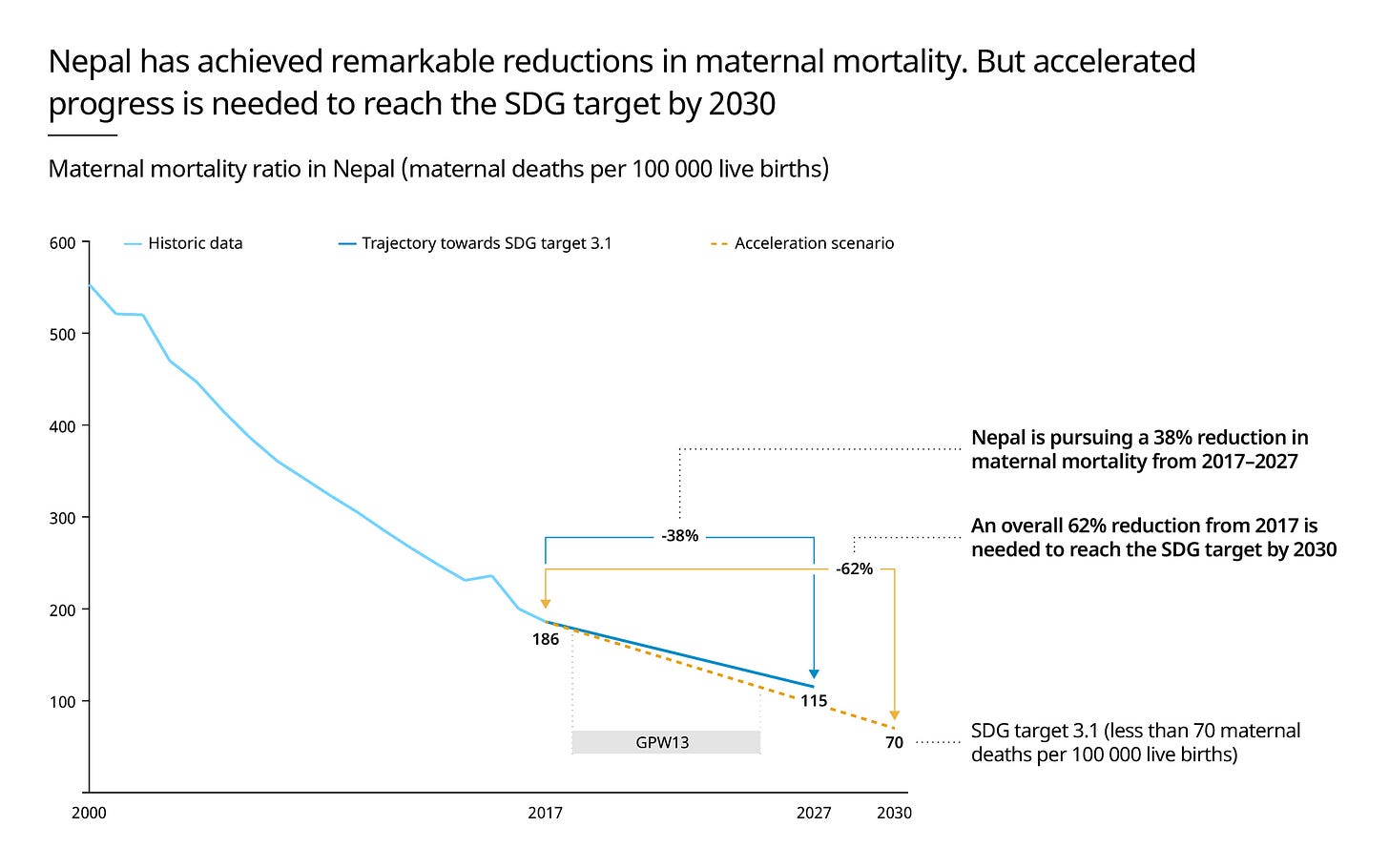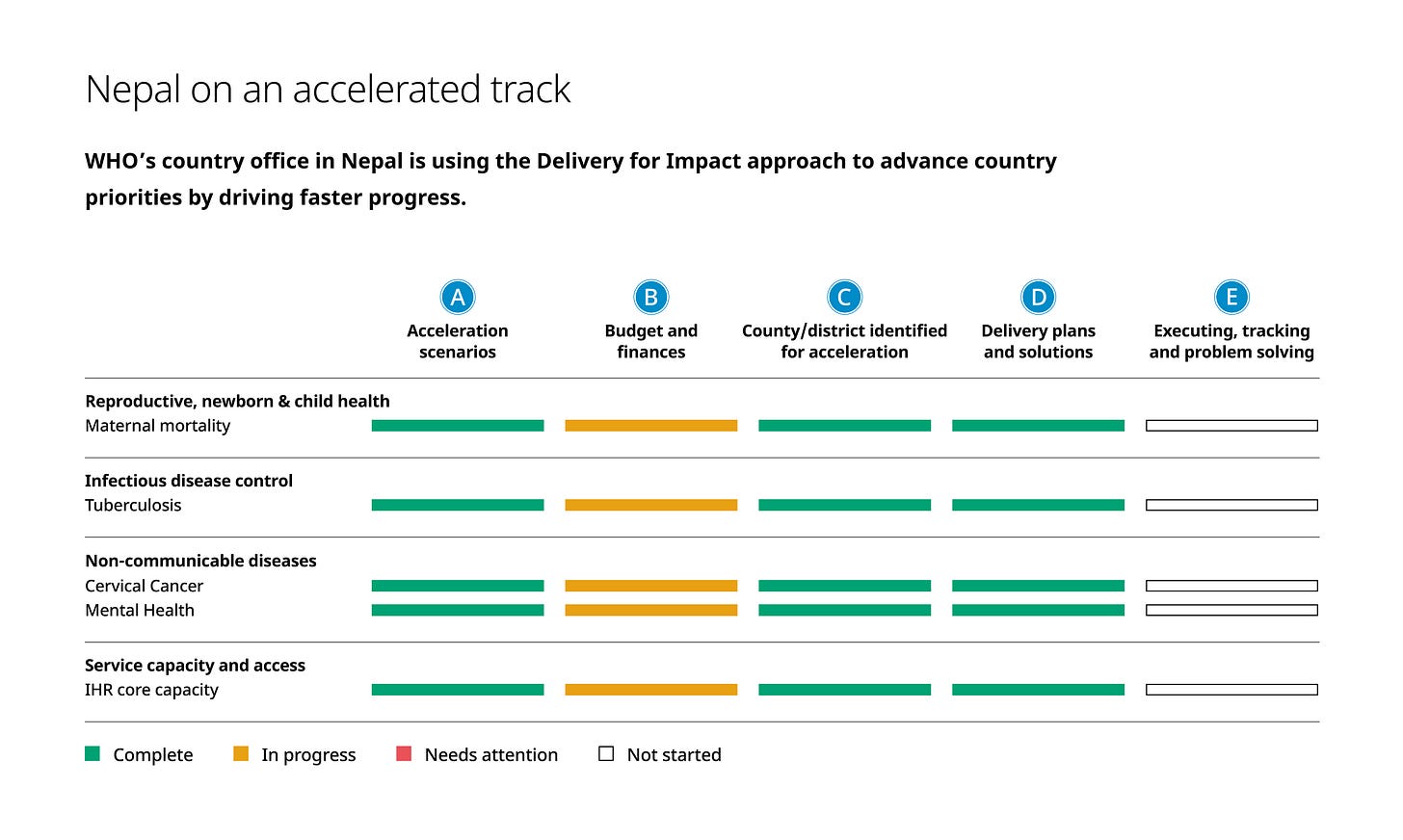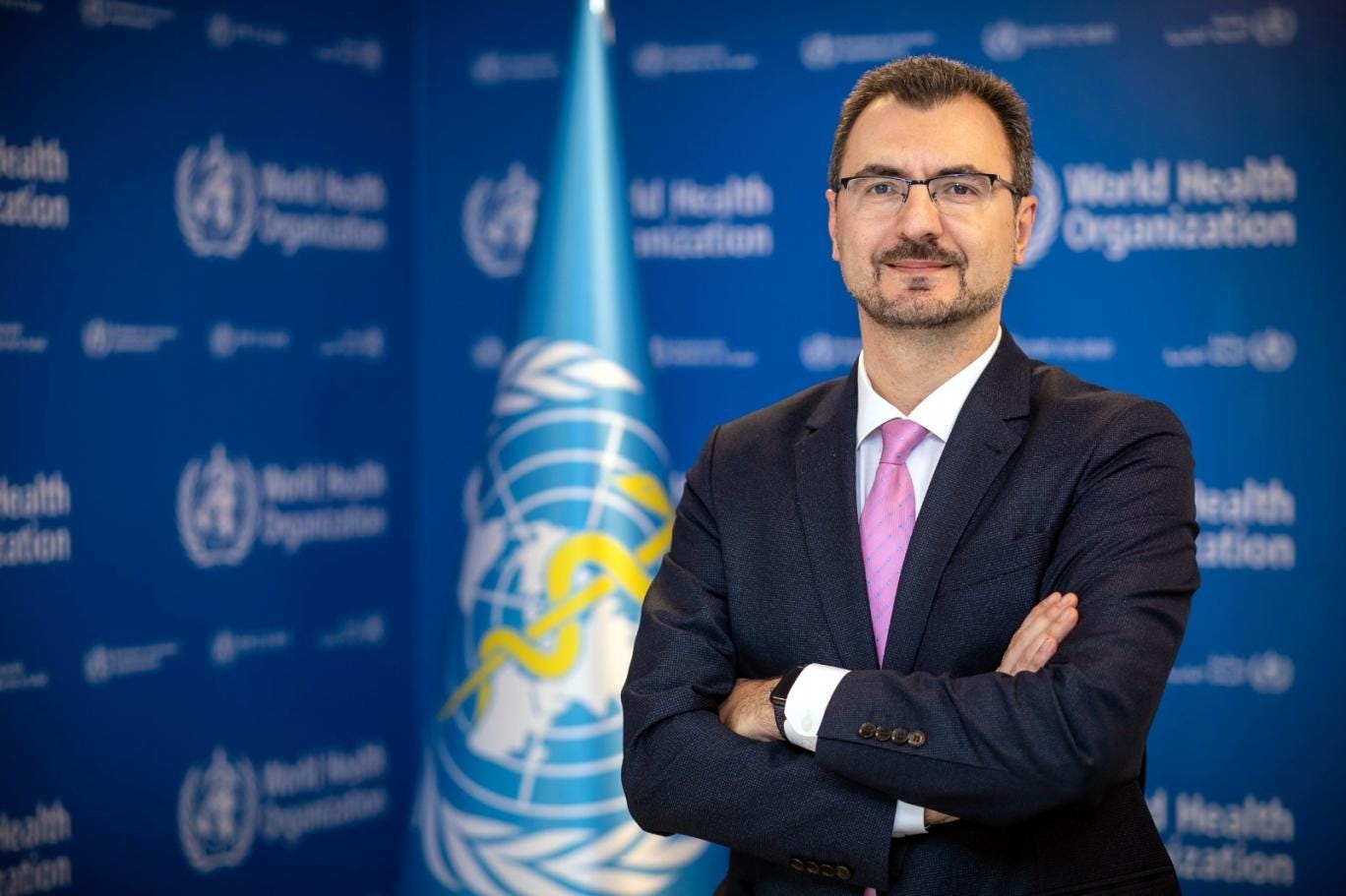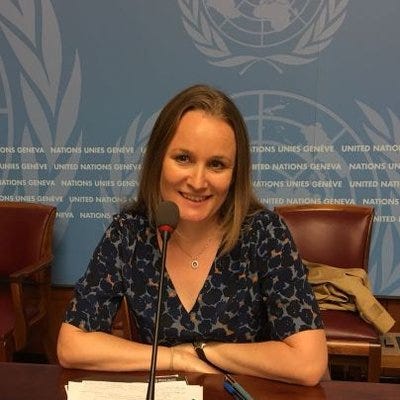Speeding up the Sustainable Development Goals
Part 2: Delivery for Impact
Execution, execution, execution. Nothing is more important for speeding up the Sustainable Development Goals (SDGs). Execution (which I use interchangeably with implementation) is the bridge between goals and outcomes.
In the last blog post, we learned that the health-related SDGs and especially Universal Health Coverage, are advancing at less than one-quarter the pace needed to reach the 2030 goals, and they have been set back, often by years, by the COVID-19 pandemic.
To accelerate progress, WHO has adopted its 5P strategy (Promote, Provide, Protect, Power and Perform for health). A key element to power health, beyond business as usual, is delivery for impact.
Originally designed for governments, over the past six years, we adapted delivery for impact for an inter-governmental organization, WHO.
This post describes how WHO introduced delivery for impact — lessons learned, challenges encountered, and future opportunities.
While I describe delivery for impact in the context of WHO, the insights will be useful for any individual or organization seeking to become more results-driven. It should be of interest to any public servant who wants to achieve better outcomes, and anyone working to reach the SDGs.
In a macroeconomic environment of decreased fiscal space, due to converging crises of COVID-19, climate and conflict, and historically high inflation and interest rates, all organizations will need to improve their efficiency and effectiveness. Delivery for impact can help.
In an earlier blog post, I wrote that my key career advice for young (and not so young) people was to find a problem and solve it. Delivery for impact is a method that any individual or organization can use to find a problem and solve it.
My top career advice for young (and not so young) people is find a problem and solve it. Delivery for impact is about how individuals and organizations find a problem and solve it.
Implementing delivery for impact in WHO
Our initial discussions on delivery for impact were in 2017 when my dear friend Senait Fisseha and I were co-chairing Dr Tedros’ Transition. Senait had experience with delivery for impact in the context of executive leadership courses for Ministers. She knew of the work of Sir Michael Barber, who had established the original “delivery unit” in government under UK Prime Minister Tony Blair.
The premise of “delivery” was simple: help governments keep their campaign promises. We immediately saw the relevance to WHO, an intergovernmental organization focused on measurable impact in countries.
Dr Tedros invited Sir Michael Barber and his experts in delivery to assess WHO’s readiness to deliver. The team found that while WHO had a clear vision, strong political commitment and effective communication on the Triple Billion targets, it lacked a central team dedicated to achievement of the targets, and that clearer processes were necessary to prioritize actions and monitor progress.
One of the early reactions to delivery for impact was “we are already doing it anyway.” While certainly in the longstanding tradition of “results based management,” there are key features which differentiate delivery for impact: focusing on fewer, clear, measurable targets; implementing through agile routines, repeatedly monitoring progress, and problem solving until targets are met; and, as implemented in WHO, tying all this closely to selected SDG indicators and targets.
In 2019, Dr Tedros established the Department of Delivery for Impact, with the mandate to bring a specific focus to delivery of the Triple Billion targets.
After much trial and error, and working with experts in delivery, we ultimately designed an approach for delivery for impact at WHO. We call it the ABCDE approach:
A. Acceleration scenarios: considering current progress toward targets, by how much can progress be accelerated?
B. Budget and finances: what resources are needed to achieve this level of acceleration?
C. Countries identified for acceleration: which are the high burden/high impact countries?
D. Delivery plans and solutions: what are the most effective interventions that WHO can support including norms and standards, technical packages, and specific innovations?
E. Executing, tracking and problem-solving: operationalizing a delivery approach, including monitoring, accountability routines and regular course-correction.
Since 2020, WHO has conducted 7 delivery stock takes to identify gaps in progress and ways to accelerate progress, elevate examples of success, and engage leaders in discussion on these challenges and opportunities.
Hosted by the Director-General, delivery stock takes report on progress toward the billion targets (healthier populations, universal health coverage, and health emergencies). The stock takes were led by the technical teams with the support of the delivery for impact team.
For example, one of these stock takes, on healthier populations, examined the rise in obesity worldwide, identified 24 high burden countries, and discussed implementation of measures in the Obesity Accelerated Action Plan (for example, tax on sugar sweetened beverages) to halt the rise.
These stock takes included country examples and presentations, but we learned that we needed to translate the approach more directly in countries to achieve our objectives of accelerating the SDGs.
Although delivery for impact may sound like its about process, what is actually at stake is the mother who died in childbirth who didn’t have to die and the mother whose life will be saved in the future.
Applying the approach in countries: Delivery for Impact 100 day challenge
The SDGs are gained or lost not in Geneva or New York but in countries. Delivery for impact really started to gain momentum just recently when it was applied in countries under the leadership of the WHO Country Representatives (WHO’s de facto Ambassadors).
We introduced it using the 100-day challenge to achieve faster progress on delivering impact in countries.* This time-bound programme sets specific health priorities for each participating country, identifying priority health areas and setting goals that will narrow the gap towards the Triple Billion targets.
Using the 100-day challenge, Nepal has selected five of these areas to drive measurable impact towards national targets by 2027 with data informed acceleration scenarios.
Priorities were determined through a bottom-up approach, where the country office, working with the regional office and headquarters, determined priorities in consultation with the ministry of health.
Maternal mortality is one of Nepal’s five priorities. Nepal has made remarkable progress towards reducing the maternal mortality ratio (MMR). In 2000, there were more than 550 maternal deaths per 100,000 live births. In 2017, the ratio was 186 per 100 000.
However, accelerated progress and renewed commitment is needed to achieve further progress towards the SDG target, which calls for a reduction in MMR to less than 70 per 100,000 by 2030.
The delivery for impact approach will help reach those objectives. Developing targets and acceleration scenarios allows monitoring of progress. And setting up routines and undertaking active problem-solving will enable the country to remain on track to achieving its goals.
Working with technical experts in WHO, the country office identified what solutions WHO will contribute to support the country to address key causes of maternal death.
Nepal is tracking progress in maternal mortality, and its four other priority areas (tuberculosis, cervical cancer, mental health, and health emergency preparedness and response), using a tailored delivery for impact dashboard.
Country-level stocktakes will regularly monitor results, to ascertain if course-correction is needed.
Nine WHO country offices have participated so far in the 100 day delivery for impact challenge: Bahrain, Dominica, Iran, Moldova, Nepal, Rwanda, Tajikistan, Vietnam, and Zambia. The leadership of the WHO Representatives on delivery for impact has been impressive and will be much needed to accelerate SDGs in countries.
Impact can take a long time, but delivery for impact can speed it up and power progress to the SDGs.
To understand the full potential of the delivery for impact approach, imagine introducing routine delivery stock takes in all countries. Led by the Minister of Health and supported by WHO, the stock takes would measure progress and identify and overcome roadblocks on a limited set of country-identified priorities.
Delivery for impact is also about accountability
As we were implementing the delivery for impact approach, we realized that it also had great promise to improve accountability.
In contrast to other accountability approaches, which focus on inputs (e.g. budgets or human resources) or generic outputs (e.g. guidelines produced, meetings held, number of countries supported), delivery for impact is closely tied to the outcomes of interest, namely the SDGs.
In the illustrative dashboard below, the columns represent elements of the delivery for impact approach; the rows represent WHO programmatic indicators from the WHO Results Framework, which are mostly SDG indicators, grouped by Triple Billion target; and the shading of the bars represents tracking of implementation by the WHO Secretariat.

If you were a member of WHO’s senior management team, the dashboard would let you know where to focus your management attention to identify roadblocks and help the Organization overcome them to best support countries to reach their SDG targets.
If you were a member of WHO’s Executive Board, the dashboard gives a snapshot of progress against WHO’s SDG-based strategy. A subsequent discussion with management, combining information from global stock takes with country experience from the 100 day challenge, could identify roadblocks, and how they will be overcome. “Programmatic accountability” is a key function of governance and has been identified as a priority in the WHO Executive Board’s own deliberations.
Challenges*
Attribution is the dark underbelly of results reporting in complex systems. Countries are responsible for SDGs; WHO is responsible for helping them. As WHO continues on its transformative journey, it must even more precisely specify its unique contribution to the Billion targets, and ensure that its teams focus on activities that accelerate impact.
No delivery without data. Support to strengthen data systems in Member States can help fill the data gaps that impede policy actions and tracking of the SDGs. Clear understanding of local needs must be maintained to ensure that WHO’s action is adapted to local contexts.
Embedding delivery for impact in management and governance. The tendency for the urgent to drive out the important works against delivery for impact, even though the numbers of preventable deaths from chronic diseases are greater than those lost in emergencies. Only by building accountability for results can WHO enhance the trust of its Member States, and only by enhancing trust can it garner needed resources to accelerate progress towards the Triple Billion targets and the SDGs.
Culture eats strategy for lunch. This quote, attributed to management guru Peter Drucker, means it’s not enough to implement a strategy of delivery for impact, it has to permeate the culture of the organization both in management and governance. It is reinforced by celebrating success, being honest about failure, communicating effectively about impact, providing the right incentives for staff, and leading by example in the things top management spends time on and emphasizes. Changing the culture of organizations, especially large bureaucracies, takes time — and the length of time is always longer than you think.
Meet Pavel and Melanie
Many people have helped to introduce delivery for impact at WHO. Samira Asma, whom I introduced in the last blog post, is a wonderful colleague and the key senior leader responsible for delivery for impact.
No one has been more directly led the introduction of delivery for impact than Pavel Ursu, Director of the Department of Delivery for Impact. Before coming to WHO Headquarters, Pavel was WHO representative in Turkey, so he understood the realities of implementation in countries. This proved to be a great asset.
Coordinating the effort is Melanie Bertram. An economist by training, Melanie brings needed analytical rigour to the exercise.
Also vital to the effort has been Claudine Menashe-Jones, working with Sir Michael Barber and his team to introduce the insights and good practices of delivery to WHO.
Conclusion
The world’s “burning platform” is the lagging SDGs. Delivery for impact is the engine to power progress to speed up the SDGs.
The opportunity for WHO now is to scale its initial experience with delivery for impact to support every country, strengthen its accountability for supporting countries to reach the SDGs, and reinforce its own culture of results. Delivery for impact also enables other ways to speed up SDGs, such as innovation and partnerships, which I will discuss in future blog posts.
Although this blog post shares the experience of WHO, delivery for impact is an essential tool for any public servant who wants to achieve outcomes, any citizen who wants to reach the SDGs, and any young (or not so young) person who wants to find a problem and solve it to gain satisfaction in their career.
* The text and figures in this section are drawn from the cited WHO publication.







Excellent points in this blog, Peter. The approach you have outlined could be useful for a country like ours (Canada) to clarify the role(s) of our federally-funded Pan-Canadian Health Organizations (PCHOs), given that health care is (mostly) funded and (almost entirely) delivered not federally, but by the provinces.